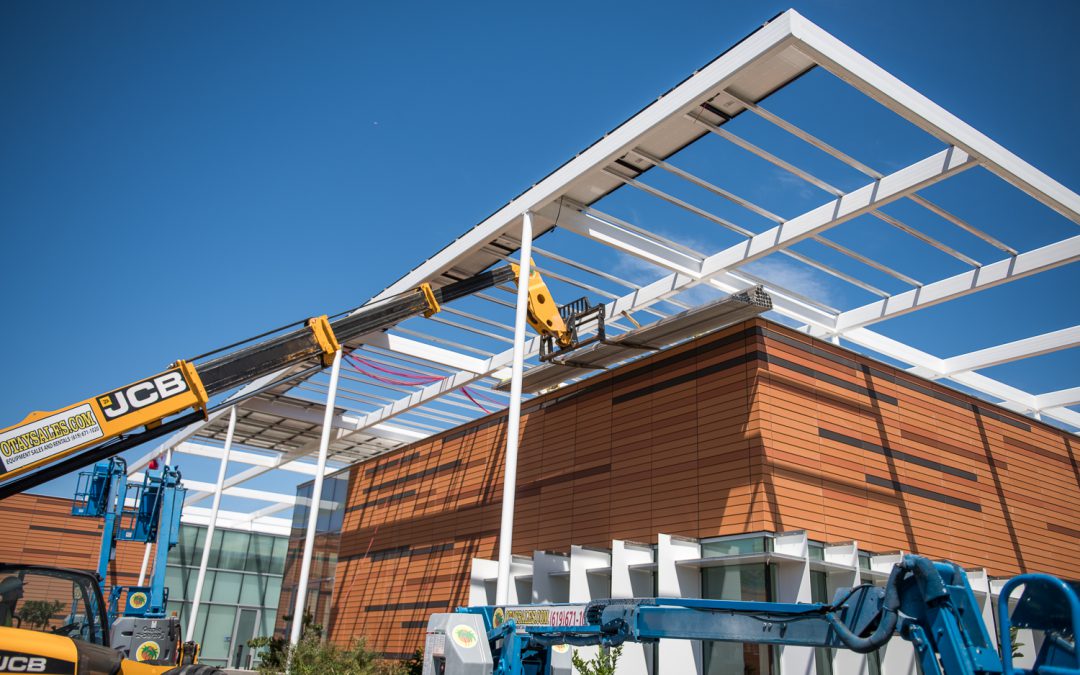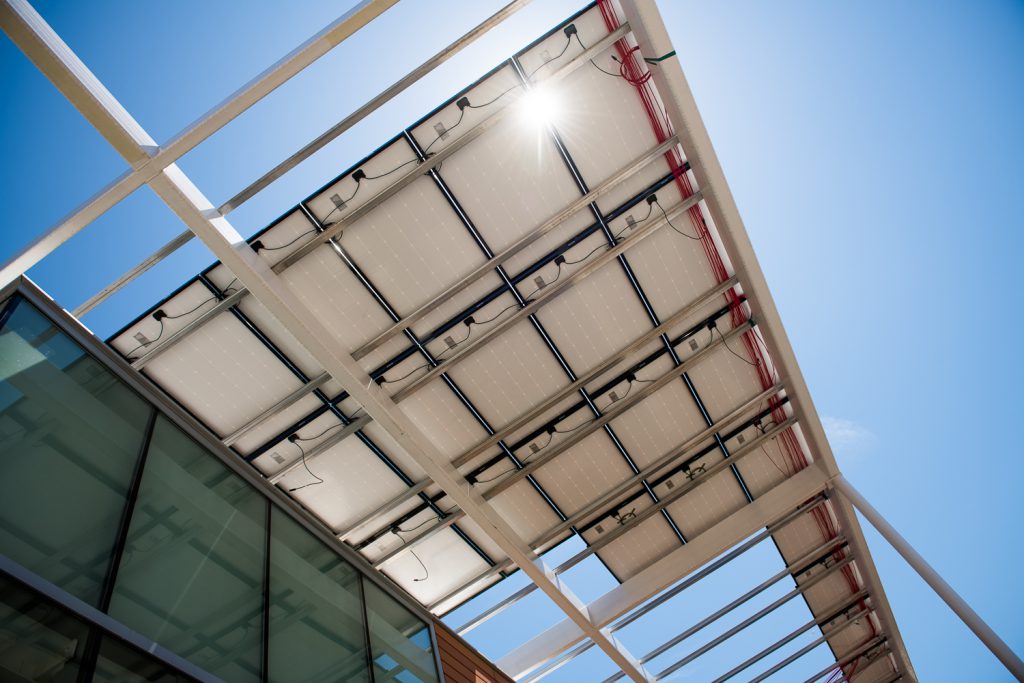With its passive design features and a solar array being installed, the Maintenance and Operations (M&O) Building at Palomar College has won more sustainability awards than any other recent project on campus.
Pictured above: The Operations wing of the M&O Building is outfitted with the first solar panels of a planned 180 KW installation on Friday, Aug. 2.
SAN MARCOS — Inside the Operations wing at Palomar College on a warm July morning, Dennis Astl’s office was cool and comfortable. Sunlight flooded in from a bank of south-facing windows. The growing heat of the day was kept beyond the walls and windows, where it would be radiant in most other buildings.
All of this combined to make the office a pleasant space for the Palomar employees working in the M&O Building. But beyond the immediate benefits, campus leaders say, the award-winning design represents a step forward in the development of sustainable building practices at higher education institutions.
Soon, M&O will become the first community college building in the world to earn Living Building Challenge’s “Petal” Certification, a Green building credential from the International Living Future Institute similar to LEED Platinum.
“At Palomar College, we’re always looking for ways to make our campus more efficient and sustainable,” said Superintendent/President Dr. Joi Lin Blake. “The success of our latest project has proven that a community college can help lead the way.”
Whereas a common approach to “net-zero” building is to simply offset the energy demand of a standard facility by installing more solar panels, M&O was designed from the ground up to save power in the first place, according to Astl, who is the college’s Manager of Construction and Facilities Planning.
“Our philosophy is to reduce the energy consumption first—as much as you can,” he said.
The results have been staggering, with half a dozen major design awards for M&O in the last 18 months.

And now, with 180 kilowatts of solar panels being installed in early August, the building will likely achieve its net-zero target by the end of the year.
The key to success?
Using the elements—daylight and fresh air—to great advantage.
Putting passive design features to work
The M&O Building is the new home of the Palomar College Facilities Department, and Astl has overseen many of the projects funded by Prop. M, the $694 million bond measure approved by voters in 2006.
By far the most efficient of those projects, M&O incorporates so-called “passive” design features that essentially use natural light and ventilation to vastly reduce the energy used on lighting and air conditioning.
With an exterior made largely of windows, the Operations wing nearest Mission Road is bright inside with very few of its LED lights running during the day.
Rows of windows mounted low to the ground on the exterior wall are set to open at a certain indoor temperature to allow cool air to flow into the building while, on the roof, more windows will open to vent the heat, creating a convection effect and circulating fresh air through the building.
Even the location of the solar panels will help cool the facility, with steel scaffolding extending over the south and west sides of the building to shade the exterior walls and windows in the middle of the day.
In the larger Maintenance wing, which houses workshops, a warehouse and other facilities, several “thermal chimneys” are used to ventilate the building on warm days and heat it during the winter.
Astl said these and other features—including rainwater tanks to save runoff from the roof—have added up to the most sustainable building on campus.
“It actually provides a much nicer building—the more daylight you get in, for example, the happier people are going to be,” he said. “When they enjoy the building, everything else is going to benefit.”
And the design has not gone unnoticed by those who are interested in sustainability engineering and its impact on higher education.
Astl has personally accepted several of the awards that M&O has won since it was built last year. That list includes:
- National “Best Green Project”—Engineering News-Record (ENR) Magazine
- “Best Green Project” in Southern California—ENR Magazine
- “Citation Award” for Technological Innovation—Design & Philanthropy Awards at the 2018 Southern California Development Forum
- “National Recognition Award”—American Council of Engineering Companies (ACEC)
- “California Honor Award”—ACEC
- “Energy and Sustainability Best Practice Award”—2019 California Higher Education Sustainability Conference
“We are proud of each of these accolades, but more importantly, the M&O Building is our line in the sand: Palomar College is committed to building facilities that are sustainable, cost-efficient to operate, and ultimately raise the bar for what can and should be done at public institutions,” said Dr. Blake.
Looking forward
Astl said it’s not as simple as putting every available feature in every new project: “It really depends on the building, on the use of the building—you have to be strategic about what features you use in what area,” he said. “Because if you don’t think that way and you just do it, it won’t be used, people will complain—it won’t work that well.”
For example, a large shared space like a classroom or community room will require a different approach than offices with cubicles and conference rooms.
Another complicating factor, according to Astl, is occupant behavior.
“People have to change the way they think, and that’s almost a more difficult thing,” he said. “We can do a lot with the building, but the building is going to perform at its best when the people take ownership, understand how the building works, and get into the habit of using it that way. It’s a two-pronged approach.”
In other words, both building and settling into M&O has been a learning experience that will inform all future projects.
“The building code is changing, and all future buildings are going to have to be net-zero,” Astl said. “And this is our strategy—to reduce the energy consumption of the building, to minimize the amount of solar panels that you need.”


